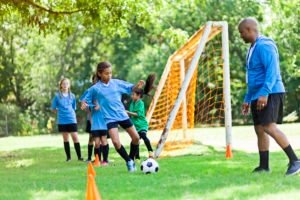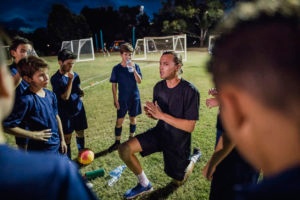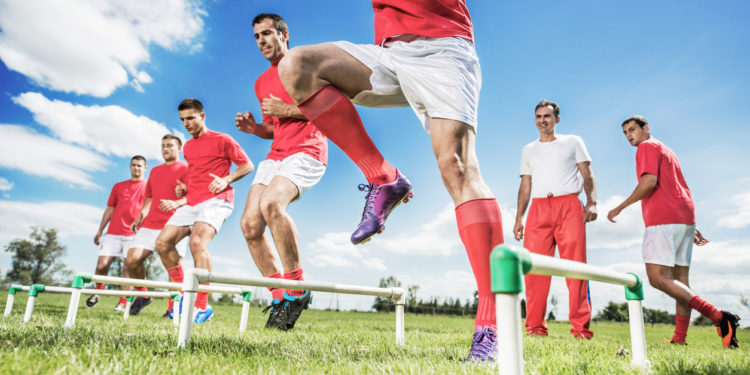When it comes to worldwide popularity soccer is at the top of the fan and participant lists. Soccer is a sport that requires all the physical attributes; strength, speed, endurance, agility and mental fortitude. Fitness training for soccer requires these skills are incorporated for a well-rounded program. Here we share some specific soccer drills that a coach, personal trainer, or even a parent, can incorporate for their soccer athletes to improve overall athleticism.
SPEED DEVELOPMENT AND CONDITIONING
The first drill is a modified YO-YO drill. This drill is used as a sprint test that incorporates acceleration, change of direction and recovery. We can use this drill as a great aerobic conditioning workout, and one that we can also use to easily quantify and see improvement.
THE SET UP: You will need an area to run that is 20 yards in distance, two stopwatches and a whistle.
EXECUTION: Place your athlete at the start line. This drill is an auditory reaction workout, therefore no pre vocal cues are used such as; get ready, get set, and go. The athlete must react on the whistle blow. When the whistle blows the athlete must run to the 20-yard line, turn around and return to the start line in a specified amount of time.
Whistle one starts the sprint, whistle two is a cue that the halfway time has been met and whistle three is the minimum time the athlete must return to the start line. The athlete then immediately sets up for the next run, waiting for the auditory cue of the starting whistle.
The coach gives only a 10 second recovery break after the last whistle. Different time frames can be used in order to challenge different levels of athletes.
10 seconds total down and back time for new athletes
<9 seconds for moderate level
<8 seconds for mid level
<7 seconds for advanced athletes
The goal of this drill is to have the athlete complete as many of these runs with the required rest time. The coach can dictate the maximum runs or set it for an X amount of time, or just test and determine when the athlete can no longer return to the start line before the last whistle blows.
STRENGTH DEVELOPMENT
The second drill is a the REVERSO. This conditioning drill is also a corrective drill in that it strengthens the soccer player’s underused muscles.
THE SET UP: Set up a square pattern with cones placed a the corners 10 yards apart.
EXECUTION: The athlete will complete a required amount of rotations or as many rotations in a required time frame determined by the coach. The exercises are as follows:
- Forward Bear Crawl 10 yards -> Lateral Bear Crawl -> Backward Bear Crawl -> Lateral Bear Crawl
- Forward Lunges 10 yards -> Lateral Lunges -> Backward Lunges -> Lateral Lunge
- Repeat Bear Crawl Box Pattern
- Forward Long Jump -> Lateral Long Jumps -> Backward Jumps -> Lateral Long Jumps - (these jumps are a huge component of plyometrics and worth incorporating)
- Repeat Bear Crawl Box Pattern
- Forward Sprint -> Lateral Shuffle -> Backpedal -> Lateral Shuffle
AGILITY & QUICKNESS
The third drill is a foot reaction drill to help the soccer player have a quicker reaction step. This drill is called the 2-2-2.
THE SET UP: The use of mini hurdles will be needed with this drill. Set up two mini hurdles that are about two feet apart, then set up two more hurdles that are two feet forward from the last hurdle. Repeat this 2-2-2 pattern with the use of 12 hurdles.
EXECUTION: The athlete will begin by standing laterally at the first set of hurdles. The coach will blow the whistle for the athlete to begin running in place. When the second whistle blows the athlete quickly runs laterally over the first set of hurdles. Once the first set of hurdles are over the athlete keeps running in place until the third whistle blows, then the athlete will sprint two yards forward and repeat the pattern through all hurdles.
This 2-2-2 drill can be performed in many ways. There is the lateral movement drill like shown above, a transverse move over the hurdles then a two foot side shuffle, or even a backward pedal can be performed by having the athlete face the opposite direction. Another option is to have the athlete perform 10 sets with varying positions and different whistle times.

Add these specific multi-adaptation drills into a soccer player’s training and to keep the exercises fun the kids or adult players! Coaches can use one or two of these drills in practice as development training or all of these with less volume as part of the practice warmup.
Want more on training athletes to perform at their peak? Check out the NASM Performance Enhancement Specialization to give clients a training edge!
















